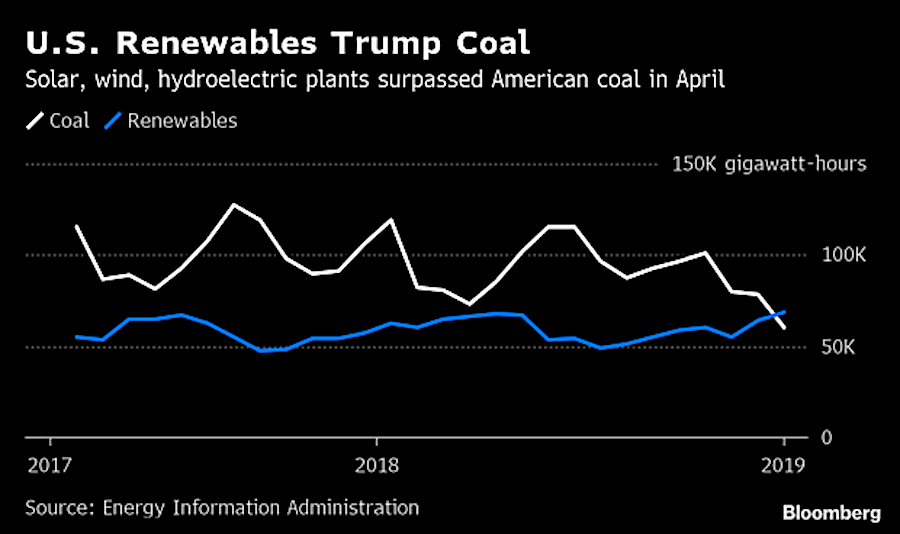
Renewable energy sources in the US now outstrip coal


According to the latest report by the Energy Information Administration (EIA), clean energy sources supplied more of the US’s electricity than coal in April this year than ever before.
Since peaking in 2008, US coal consumption has plunged 39% to the lowest level in 40 years
EIA’s Monthly Energy Review
The breakthrough reflects the declining cost of solar and wind and also heightened environmental concerns about coal.
Some of it is also because of seasonal issues, such as planned shut downs for some coal plants due to maintenance. In spring, demand for electricity is low and the season also tends to be a strong period for hydro and wind power.
Since peaking in 2008, US coal consumption has plunged 39% to the lowest level in 40 years, despite President Donald Trump’s promises to prop up the industry by revoking or lightening up environmental rules.
The country’s renewable energy sector proved to have slightly more installed capacity than coal, which means that US power plants were able produce more energy from clean sources than the fossil fuel in April, for the first time in history.
A Federal Energy Regulatory Commission report shows the total available installed generating capacity of coal stood at 257.48 gigawatts two months ago. Renewable energy — including not just solar and wind but also water, biomass and geothermal steam — narrowly overtook coal by climbing to 257.53 gigawatts of installed capacity that month.

Despite the numbers, renewables aren’t expected to overtake coal on an annual basis for several years.
Analysts at Global Risk Insights note that coal continues to be the US’s leading source of carbon emissions that contribute to climate change and the effects coal pollution are estimated to kill about 7,500 Americans every year.
The pace of the change, however, is picking up — it was only three years ago when coal was first surpassed by natural gas as the US’ main power source.


Trump weighs using $2 billion in CHIPS Act funding for critical minerals

Codelco cuts 2025 copper forecast after El Teniente mine collapse

Electra converts debt, launches $30M raise to jumpstart stalled cobalt refinery

Barrick’s Reko Diq in line for $410M ADB backing

Abcourt readies Sleeping Giant mill to pour first gold since 2014

Nevada army depot to serve as base for first US strategic minerals stockpile

SQM boosts lithium supply plans as prices flick higher

Viridis unveils 200Mt initial reserve for Brazil rare earth project

Tailings could meet much of US critical mineral demand – study

Kyrgyzstan kicks off underground gold mining at Kumtor

Kyrgyzstan kicks off underground gold mining at Kumtor

KoBold Metals granted lithium exploration rights in Congo

Freeport Indonesia to wrap up Gresik plant repairs by early September

Energy Fuels soars on Vulcan Elements partnership

Northern Dynasty sticks to proposal in battle to lift Pebble mine veto

Giustra-backed mining firm teams up with informal miners in Colombia

Critical Metals signs agreement to supply rare earth to US government-funded facility

China extends rare earth controls to imported material

Galan Lithium proceeds with $13M financing for Argentina project

Kyrgyzstan kicks off underground gold mining at Kumtor

Freeport Indonesia to wrap up Gresik plant repairs by early September

Energy Fuels soars on Vulcan Elements partnership

Northern Dynasty sticks to proposal in battle to lift Pebble mine veto

Giustra-backed mining firm teams up with informal miners in Colombia

Critical Metals signs agreement to supply rare earth to US government-funded facility

China extends rare earth controls to imported material

Galan Lithium proceeds with $13M financing for Argentina project

Silver price touches $39 as market weighs rate cut outlook

















